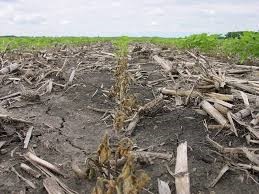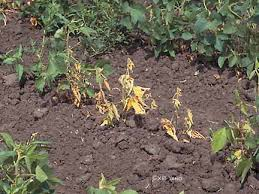Spring weather conditions went from cold to dry to hot and wet, creating a perfect storm.
The 2018 growing season started off well for many local growers as many reported seeing fast emergence and good stand establishment, for the most part. As recently noted by many growers, beans have raced through the vegetative stage and quickly entered the reproductive phase ahead of schedule. But, a broad portion of central Illinois experienced an early season lack of widespread rainfall and good environmental conditions. See MRCC’s data for May. https://mrcc.illinois.edu/cliwatch/months/m05_18.pperc.png
Then conditions began to turn to periods of heavy rain with flooding and ponding potential. In fact, data from the Midwest Regional Climate Center show a large portion of Illinois soils have received 100 to 300 percent of their monthly precipitation to date and there is still a full week to go in June with more moisture in the forecast. https://mrcc.illinois.edu/cliwatch/mtd/month.pperc.png

Well, as one can imagine, with all this free water lying about there is ample evidence of less than healthy plants due to wilting, and the number of dead soybean plants is on the rise. Yes, most farmers today use seed treatments to aid in reducing the potential for infection. But, remember these substances, while systemic and active within the plant, are on the seed surface and are subject to water solubility effects which can impact the duration of their efficacy.
In short, when these growing and environmental conditions collide creating the perfect storm the outcome is often less than desirable, leading growers to question the expense of seed treatments. During this perfect storm these multiple opportunistic soybean pathogens start rapidly contaminating on growing plants and can greatly reduce stand, plant vigor and overall plant heath. These diseases individually can cause damage and, heaven forbid, should soggy fields encounter multiples of these infectious pathogens stands can quickly show signs of irreversible yield loss.
Rhizoctonia prefers hotter and dryer weather as was experienced in central and southern portions of Illinois early on. Early infections likely compromised root systems under these plants. Symptoms include sunken reddish to brown lesions running up the side of younger soybean plants.

Phytophthora root rot (PRR) can infect soybean plants about anytime of the year. And even if a variety carries an Rps gene(s) as part of its defense package that does not mean later season infections of this disease won’t do damage. PRR field tolerance scores are typically a better barometer of a plant’s ability to handle later season infections from this pathogen. PRR root infections cause weakened and rotted root tissue, preventing plants from accessing the resources they need to maintain vitality and heath. This pathogen prefers the hotter and wetter soil conditions that were so prevalent in June.
Pythium is another root disease that really has no set time of infective ability and causes similar symptoms in the plant’s root system, but it prefers cooler conditions compared to Phytophthora.
Fusarium is another root infecting disease that may cause early onset wilting and early season plant death. This is also the causal agent for Sudden Death Syndrome in soybean plants. Later season infections may not be evident until the plant progresses into the pod and seed set stages. So, keep an eye on fields throughout the balance of this growing season if damage is currently evident.


 and then
and then